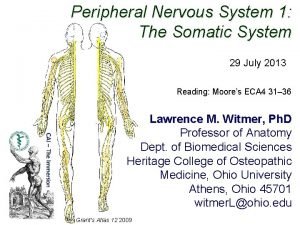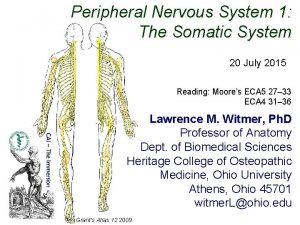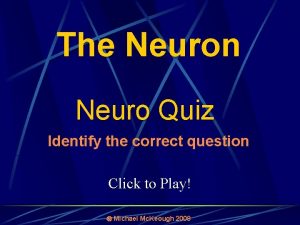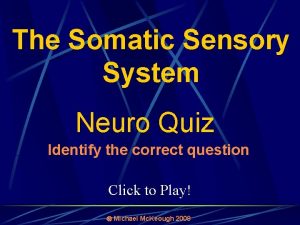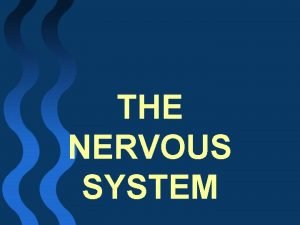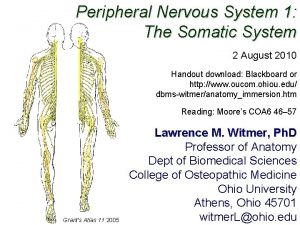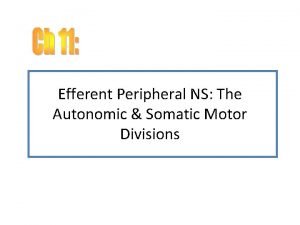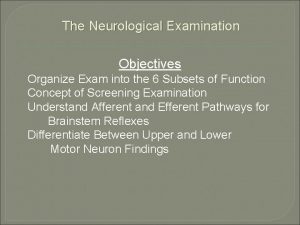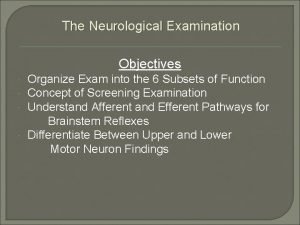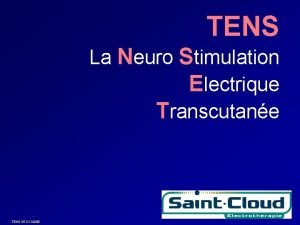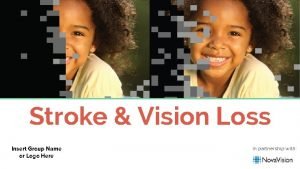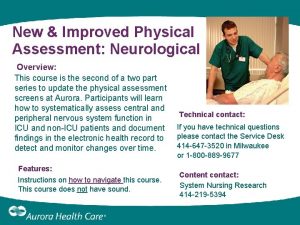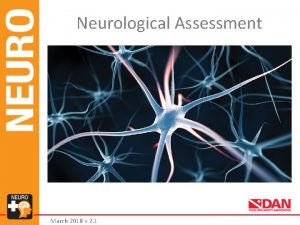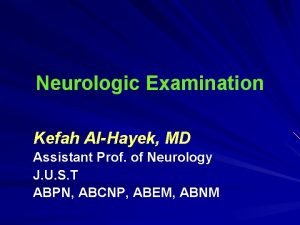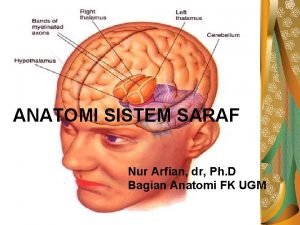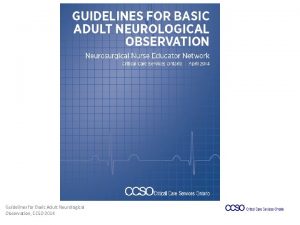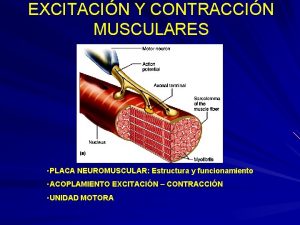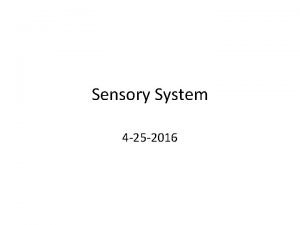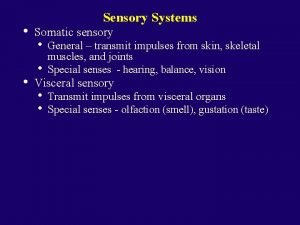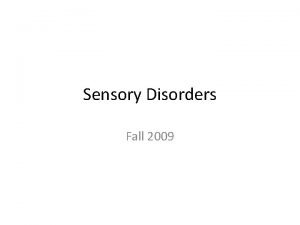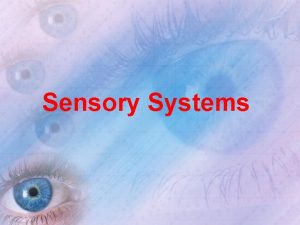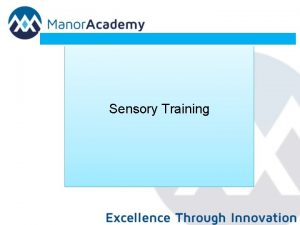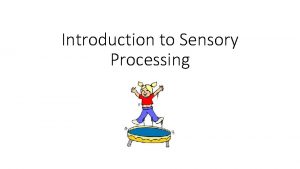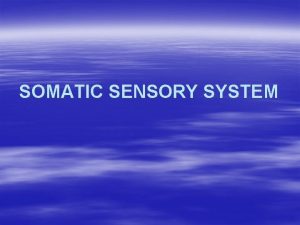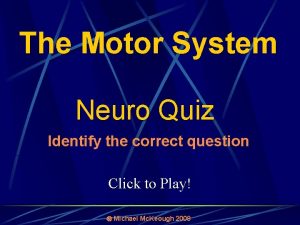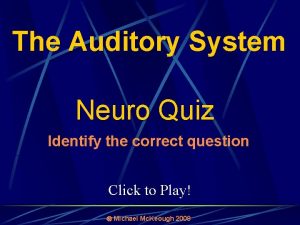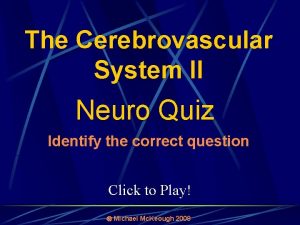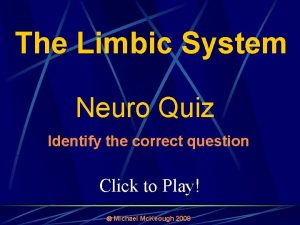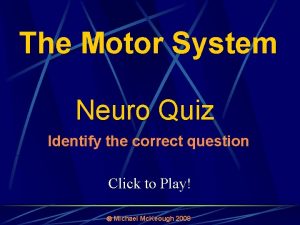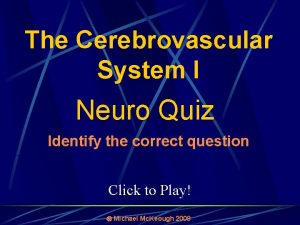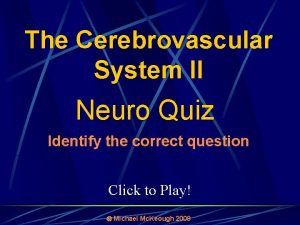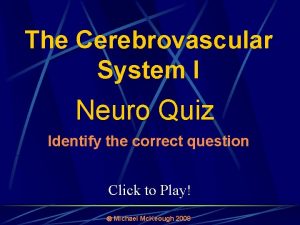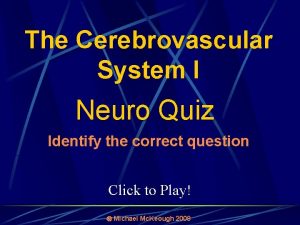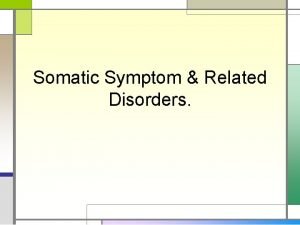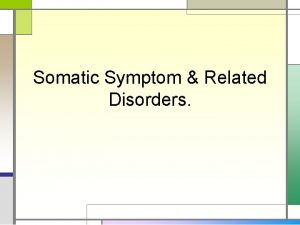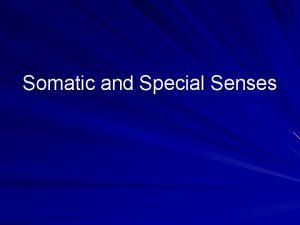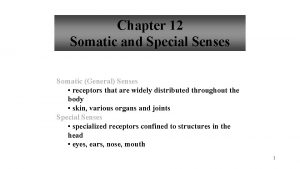The Somatic Sensory System Neuro Quiz Identify the



























- Slides: 27

The Somatic Sensory System Neuro Quiz Identify the correct question Click to Play! Michael Mc. Keough 2008

Somatic Sensory System Neuro Quiz Physiology DCML Spinothalamic System Trigeminal System Pathology 100 100 100 200 200 200 300 300 300 400 400 400 500 500 500 Click category value to begin.

Physiology 100 This constitutes information for the sensory system. What is a significant change in energy level? Click to reveal the question Return to Game Board

Physiology 200 This is defined as the energy change sufficient to cause receptors to generate a receptor potential. What is an adequate stimulus? Click to reveal the question Return to Game Board

Physiology 300 These neurons relay information from receptors in the periphery into the CNS. Their cell bodies are located in DRG or CNN. They are pseudo-monopolar cells. What are first-order neurons? Click to reveal the question Return to Game Board

Physiology 400 This is the process by which sensory receptors transform changes in the adequate stimulus into changes in neuronal discharge (electrochemical energy). What is information transduction? Click to reveal the question Return to Game Board

Physiology 500 This is the form of energy to which skin, muscle, and joint receptors are most sensitive. What is mechanical deformation? Click to reveal the question Return to Game Board

DCML 100 These are the sensory modalities to which the DCML is selectively sensitive. What are discriminative tactile sense, conscious proprioception, vibration, and stereognosis? Click to reveal the question Return to Game Board

DCML 200 This is the spinal pathway by which discriminative tactile information from the upper extremity is conveyed. It is located laterally in the dorsal column, from T 6 and above. What is the fasciculus cuneatus? Click to reveal the question Return to Game Board

DCML 300 This is the thalamic relay center for the DCML. It contains the cell bodies of third-order neurons. What is the ventral posterior lateral (VPL) nucleus? Click to reveal the question Return to Game Board

DCML 400 Third-order neurons projecting from the thalamus to the primary sensory cortex pass through this area. This white matter area separates the thalamus from the caudate nucleus. What is the internal capsule? Click to reveal the question Return to Game Board

DCML 500 This construct depicts the somatotopic organization of the primary sensory cortex. It portrays a distorted representation of the body where body parts are portrayed proportional to the amount of brain space dedicated to the control of that body part. What is the sensory homunculus? Click to reveal the question Return to Game Board

Spinothalamic System 100 The modalities to which the spinothalamic system is most sensitive. What are pain and temperature from the contralateral body? Click to reveal the question Return to Game Board

Spinothalamic System 200 The component of the spinothalamic system that conveys information about slow (clinical) pain. What is the paleospinothalamic tract? Click to reveal the question Return to Game Board

Spinothalamic System 300 At or about the level of entry. What is the level of the neuraxis at which this system crosses the midline (decussates)? Click to reveal the question Return to Game Board

Spinothalamic System 400 The thalamic relay center by which information about pain and temperature makes its way into the limbic system. What is the intralaminar nucleus ? Click to reveal the question Return to Game Board

Spinothalamic System 500 The type of organization found throughout this system. Helps account for why patients may have difficulty localizing the source of their pain. What is not somatotopically organized? Click to reveal the question Return to Game Board

Trigeminal System 100 The modalities to which the trigeminal system is most sensitive. What are pain and temperature from the contralateral face? Click to reveal the question Return to Game Board

Trigeminal System 200 The dermatomes of the face. What are the ophthalmic, maxillary, and mandibular? Click to reveal the question Return to Game Board

Trigeminal System 300 The pathway by which first-order neurons project to second-order neurons. What is the descending tract of the trigeminal nerve (CN V)? Click to reveal the question Return to Game Board

Trigeminal System 400 The location of the cell bodies of second-order neurons in the central trigeminal system. What is the spinal nucleus of the trigeminal system? Click to reveal the question Return to Game Board

Trigeminal System 500 The thalamic relay center for trigeminal information in route to the primary sensory cortex. What is the ventral posteromedial (VPM) nucleus? Click to reveal the question Return to Game Board

Pathology 100 Following a lesion of the primary sensory cortex, the side of the body on which sensory impairments appear. What is contralateral or opposite? Click to reveal the question Return to Game Board

Pathology 200 The inability to recognize objects by their tactile qualities in the absence of vision. What is astereognosis? Click to reveal the question Return to Game Board

Pathology 300 The leading theory of analgesia. Pain relief is produced by the activation of the periaqueductal gray nucleus and release of encephalon. Encephalons lodge in postsynaptic receptor sites of transmission neurons blocking the uptake of transmitter substance from first-order neurons. What is the opiate theory? Return to Click to reveal the question Game Board

Pathology 400 Symptoms of this condition include: Spastic paralysis on the same side as the lesion. l Absence of discriminative tactile, vibration, and conscious proprioception sensation on the same side as the lesion. l Absence of pain and temperature sensation on the side opposite the lesion. l What is a hemisection of the spinal cord or Brown-Sequard syndrome? Click to reveal the question Return to Game Board

Pathology 500 Symptoms of this condition include: Absence of pain and temperature sensation in the ipsilateral face and contralateral body. l Loss of corneal reflex, ipsilaterally. l Nystagmus and ataxia. l What is lateral medullary or Wallenberg syndrome? Click to reveal the question Return to Game Board
 Visceral afferent vs efferent
Visceral afferent vs efferent Peripheral
Peripheral Sensory vs somatic
Sensory vs somatic Tabes dorsalis syphilis
Tabes dorsalis syphilis Neuro q quiz
Neuro q quiz Sensory system quiz
Sensory system quiz Sns somatic nervous system
Sns somatic nervous system Neurotransmitters in somatic nervous system
Neurotransmitters in somatic nervous system Somatic nervous system
Somatic nervous system Visceral nervous system
Visceral nervous system Somatic nervous system
Somatic nervous system Autonomic nervous system skeletal muscle
Autonomic nervous system skeletal muscle Pns
Pns Divisions of the nervous system
Divisions of the nervous system Autonomic receptors
Autonomic receptors Somatic motor division
Somatic motor division Neuro exam strength
Neuro exam strength Neuro exam strength
Neuro exam strength Tens neuro
Tens neuro Neuro eye coach
Neuro eye coach Nihss best language
Nihss best language Neuro wdl
Neuro wdl Neuro vital signs meaning
Neuro vital signs meaning Reflex grading scale
Reflex grading scale Sulcus centralis
Sulcus centralis Site:slidetodoc.com
Site:slidetodoc.com Psychiatry shelf percentiles
Psychiatry shelf percentiles Estructura de la placa neuromuscular
Estructura de la placa neuromuscular
